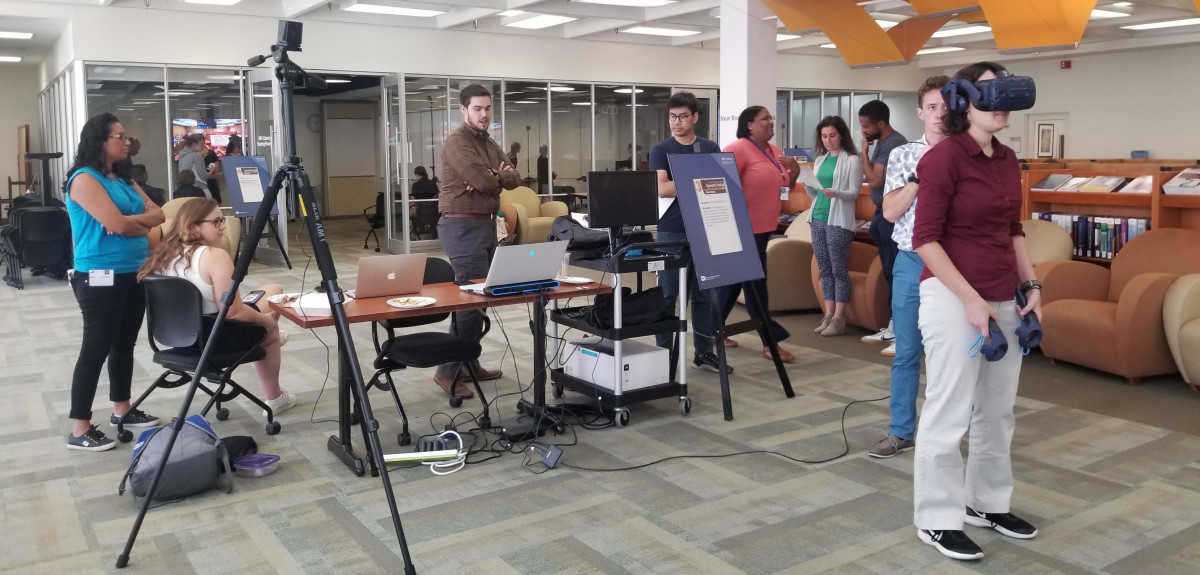Virtual Realities, Real Discoveries
Susan Persky uses immersive simulations to understand how genomic information influences people’s health behaviors.

Members of Dr. Persky’s group demonstrate virtual reality technology in the NIH Library.

Dr. Susan Persky
As the newest frontier in entertainment, virtual reality (VR) conjures fictional worlds where soaring over skyscrapers or battling supernatural enemies are as easy as a flick of the wrist. But in her lab, Susan Persky, Ph.D., uses VR in a more practical context.
In the real world, where personalized genetic tests are broadly available through companies like 23andMe and Ancestry, understanding how to appropriately convey the outcomes of these tests may be as important as the results themselves. Using immersive VR technology, Dr. Persky leads the Immersive Simulation Program at the NIH’s National Human Genome Research Institute (NHGRI) in simulating realistic interactions to test how individualized genetic and genomic information delivered in a clinical setting can affect health decisions. By studying people’s responses to the virtual experience, her team is hoping to answer questions about how best to communicate with people about their genes and their environment.
“Virtual reality and genomics of common disease are both emerging fields,” says Dr. Persky. “As we move towards precision medicine, we can apply VR to help us figure out best practices for translating genomics in everyday clinical situations.”
Consider a hypothetical example of what may be a routine medical appointment in the not-so-distant future. A doctor might explain underlying genetic factors that predispose a patient to be at-risk for diabetes or obesity. How the doctor contextualizes the information may influence the patient’s attitudes about his or her condition. If the doctor discusses how genes play into risk for disease, the patient might feel less in control, but also less stigmatized if he isn’t able to lose weight. Alternatively, if the doctor solely emphasizes behavior as a determinant for health, the patient may blame himself for his condition but also may feel more empowered to adopt health-promoting habits. The challenge lies in achieving the best of both worlds: talking about genetic and environmental factors in a way that reduces stigma and blame and also encourages healthy behavior.

A virtual doctor greets a participant in one of Dr. Persky’s VR studies.
In that pursuit, Dr. Persky carries out these types of scenarios in her lab — or, rather, her virtual doctors do. Her methods allow close assessment of what these discussions may one day look like while side-stepping many of the obstacles faced by similar studies.
“We want to optimize conversations of the future,” Dr. Persky says. “Clinical visits tend not to be a good place to run experiments. And doing these studies in a controlled lab would not be very realistic.”
VR strikes the balance between realism and control. The experience is immersive enough that the researchers can get a better idea of how patients would react in the real world, instead of relying on patients to imagine themselves in these situations and record their responses on a traditional survey. And because the researchers can manipulate everything the participant will encounter — from the doctor’s appearance to the exact words the doctor uses — VR supports a more controlled, standardized approach than performing these studies in a real physician’s office, where variability is inevitable.
Virtual reality also offers the opportunity to gather more nuanced data that would otherwise be difficult to obtain in the real world. By its very nature, the VR interface needs to track where users are looking and their relative position in the room. Dr. Persky leverages this information automatically generated by the system to measure participants’ nonverbal behaviors, like eye contact and body language. Together with formal responses, nonverbal cues can reveal people’s psychological states as they’re engaging in these simulations and perhaps even help predict their future behavior.
To confirm that people act similarly in and out of VR, Dr. Persky’s team has paired virtual experiences with real-world equivalents. In preparation for one set of experiments, parents received messages about the inheritance of genes that could put their kids at an increased risk of obesity in adulthood. When the parents slipped on the VR headset, they were transported to a virtual buffet replete with food options like salad, pasta, brownies, and fountain drinks where they were asked to make a plate of food for their kid. Parents who received information about the genomic risk for their child’s future chose fewer calories from the virtual buffet for their child’s meal. A related experiment showed that presenting risk in terms that stressed a gene-environment interaction was associated with fewer calories than when providing information about genetics alone.

Pasta from the virtual buffet (left) closely resembles real pasta made by the Clinical Center’s Metabolic Kitchen (right).
The researchers then ran another trial, this time presenting parents with identical-looking real food, and compared their choices to the VR servings. The group found that parents chose similar serving sizes in reality and VR. These studies not only corroborated that people behave similarly in VR and the real-world, but it provided further evidence that the messaging used to present genomic information matters when it comes to shaping health behaviors.
“Parents who received information about gene-environment interactions understood that their child did have an increased risk of obesity, but that they also had this environmental lever that they had some control over,” Dr. Persky explains.
Still, even when the message is the same, different people might receive it differently. For example, in one of its studies, Dr. Persky’s team discovered that when given genetic information about weight, black women felt more stigmatized and had less trust in the physician than white women. The reason for the difference is likely related to a history of racial discrimination and ongoing racial disparities. As we head towards a future where both genomic data and channels of communication continue to expand, Dr. Persky’s work emphasizes the importance of honing the genomic information we provide to increase its value for individuals and communities.
“Just like personalized medicine, you might need some personalized communication or at least targeted communication,” Dr. Persky says. “I think the importance of what we're doing is that we're showing that one size health communication does not fit all.”
Susan Persky, Ph.D., is a Senior Investigator in the Social and Behavioral Research Branch at the National Human Genome Research Institute (NHGRI).
This page was last updated on Wednesday, May 24, 2023